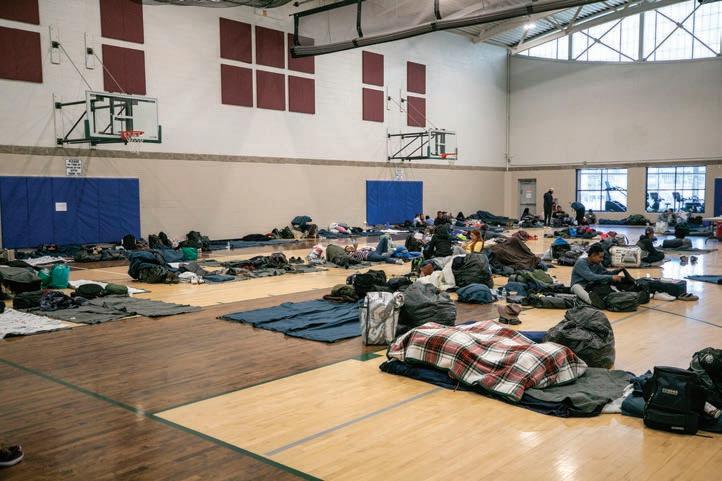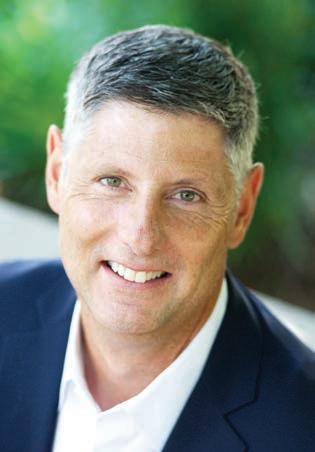
5 minute read
Denver bought one-way bus tickets for 1,900 migrants
Where they went
Denver spent nearly a halfmillion dollars last month buying one-way Greyhound bus tickets to other cities for 1,900 migrants who arrived here after crossing the U.S. southern border, according to data released Friday to e Sun by city o cials.
e most popular destinations were New York and Illinois, but also Florida, Georgia and Texas.
e spending does not include tickets purchased by the city so far in January, or spending by the state, which paid for chartered buses for four or ve days this month to send groups of migrants to other destinations, mainly New York City and Chicago.
Denver sent 399 migrants to Chicago and 345 to New York City in December. e city also sent 122 to Atlanta, 95 each to Miami and Orlando, and 68 to Dallas. In all for the month, the city spent $492,000 on bus tickets.
State o cials have not yet responded to requests from e Sun for an accounting of the number of people taken to other cities on chartered buses.
Sending migrants to other destinations has been controversial.
e mayors of New York City and Chicago last week sent a letter to Colorado Gov. Jared Polis saying they “respectfully demand that you cease and desist sending migrants” to their cities. Chicago Mayor Lori Lightfoot and New York City Mayor Eric Adams said they had received hundreds of migrants from Colorado since December.
Polis said Colorado was stepping in to help people, mainly from politically unstable Venezuela, reach their nal destinations, where he said they had family or friends. He estimated 70% of migrants who arrived in Colorado during the past month were trying to get somewhere else. But he called o the chartered bus operations after talking to Lightfoot and Adams last week.
Denver o cials, meanwhile, reiterated Friday that none of the migrants was asked to leave the city, which has been housing hundreds of people each night in three emergency shelters set up to handle the in ux of newcomers, many of whom have arrived without warm clothing and wearing sandals. Since Dec. 9, more than 4,100 migrants from Central and South America have arrived in Denver.
“I want to ensure that it’s doubly clear that each of these passengers have asked for assistance to get transportation to these destinations and we facilitated their trips by purchasing tickets,” said Mikayla Ortega, a spokeswoman for Denver’s O ce of Emergency Management, which is operating the emergency shelters.
Denver’s one-way ticket purchases and the Democratic governor’s short-lived chartered busing operation thrust the state into a national controversy that began last spring, when other governors began sending migrants around the country.

Texas Gov. Greg Abbott, a Republican, sent thousands of migrants to Chicago, Washington, D.C., and New York during the spring and summer. And on Christmas Eve, two buses dropped o about 100 people outside the home of Vice President Kamala Harris in Washington. e White House blamed the Texas governor, who said he was fed up with federal immigration policy. In September, Florida Gov. Ron DeSantis, also a Repub- lican, spent state funds to round up about 50 migrants in Texas and y them to the island of Martha’s Vineyard in Massachusetts, calling it a relocation program. e migrant arrivals dropped o this week, down to about 50 people per day rather than more than 100 per day a couple of weeks ago. Denver planned to begin dismantling the shelters, consisting of cots and mats in the city’s recreation centers, and asked more community groups to step up to house migrants. is story is from e Colorado Sun, a journalist-owned news outlet based in Denver and covering the state. For more, and to support e Colorado Sun, visit coloradosun. com. e Colorado Sun is a partner in the Colorado News Conservancy, owner of Colorado Community Media. intermediate targets before 2050 is “the best way to ensure we get there,” she said.

Colorado o cials have said they do not believe the migrants were sent here by any other state, but that they organized their trips based on information from nonpro ts and fellow travelers. Word spread quickly that Denver, a socalled sanctuary city because local law enforcement does not cooperate with immigration o cials seeking to deport people for not having required documentation, had warm shelter beds and food.

About 500 people were sleeping in the city’s three shelters each night this week, and about 550 at other shelters in the community.


“We’re falling behind when it comes to meeting our current goals. We need more investment,” Hansen said. e federal In ation Reduction Act puts real money behind changes needed to make climate goals, he added.
“ at has drastically lowered the price of climate tech across the spectrum,” he said. “So I think we really need state policy that’s going to accelerate and take advantage of that federal action.”
Hansen is one of dozens of candidates who have declared themselves for Denver’s spring mayoral race.
Lynn Granger, Midwest and Mountain West region director for the American Petroleum Institute, said the trade group is “generally supportive” of many elements of the bill, including a provision giving the Colorado Oil and Gas Conservation Commission authority to regulate injection wells for carbon sequestration. API said it is concerned, however, about one measure “which appears to compel PERA to divest from its energy investments.”
“Colorado remains an irreplaceable foundation of American energy security, and we are con dent that the nal iteration of this e ort can coexist with that reality,” Granger said.
Hansen’s Senate Bill 16 is co-spon- sored by Democratic Reps. Karen McCormick, Longmont, and Emily Sirota, Denver.
Some key measures of the multifaceted bill:
• Sets new greenhouse gas reduction goals of 65% from 2005 benchmark levels by 2035, 80% by 2040, 90% by 2045 and 100% in 2050. e state’s current greenhouse gas reduction targets from a 2019 law are set at 26% in 2025, 50% by 2030, and 90% by 2050.
• Requires the PERA board by June 1, 2024, to adopt proxy voting procedures that “ensure that the board’s voting decisions align with, and are supportive of, the statewide greenhouse gas emission reduction goals.”
• Adds wastewater thermal energy to the de nition of “clean heat resource.” Wastewater pipes can transfer their heat to clean water pipes that circulate to heat or cool ambient air in nearby buildings. A utility could include wastewater energy in its clean heat plan led with the Public Utilities Commission. Gives the Colorado Oil and Gas Conservation Commission authority over injection wells used for sequestration of greenhouse gasses, in part to give state authorities “primacy” over federal rules for the Safe Drinking Water Act.
• Requires local governments to expedite review of land use applications involving the renovation, rebuilding or reconditioning transmission lines.
• Beginning in 2024, insurance companies doing business in Colorado with more than $100 million of activity must participate in and complete a national “Insurer Climate Risk Disclosure Survey.”




• Creates a 30% tax credit for qualifying clean electric lawn and garden equipment like mowers, trimmers, and leaf or snow blowers. e retailer would be able to claim the credit and take the amount o the price at the point of sale.
With Colorado “o the track” of its greenhouse gas reduction goals, the bill could help in “clarifying the scope and pace the state must achieve,” said Michael Hiatt, deputy managing attorney for Earthjustice’s Rocky Mountain o ce.
“But to actually achieve these goals, Colorado must accelerate its actions on climate and fully utilize the new federal funding that will make it even more a ordable for
Coloradans to drive electric vehicles, install rooftop solar and energy efciency measures, and stop burning fossil gas in their homes,” he said.
Jeremy Nichols, director of the climate and energy program for WildEarth Guardians, said “It’s encouraging to see legislative interest in reinforcing the need for major greenhouse gas reductions over the coming decades.” is story is from e Colorado Sun, a journalist-owned news outlet based in Denver and covering the state. For more, and to support e Colorado Sun, visit coloradosun. com. e Colorado Sun is a partner in the Colorado News Conservancy, owner of Colorado Community Media.


















